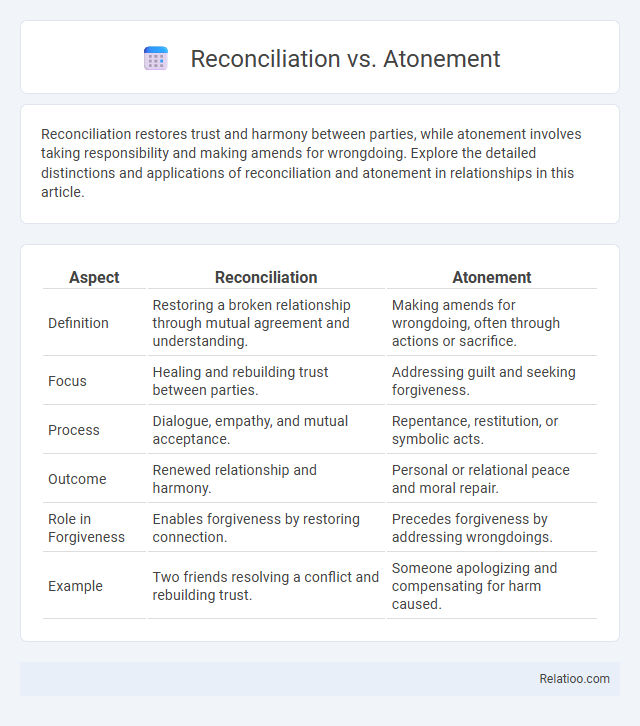Reconciliation restores trust and harmony between parties, while atonement involves taking responsibility and making amends for wrongdoing. Explore the detailed distinctions and applications of reconciliation and atonement in relationships in this article.
Table of Comparison
| Aspect | Reconciliation | Atonement |
|---|---|---|
| Definition | Restoring a broken relationship through mutual agreement and understanding. | Making amends for wrongdoing, often through actions or sacrifice. |
| Focus | Healing and rebuilding trust between parties. | Addressing guilt and seeking forgiveness. |
| Process | Dialogue, empathy, and mutual acceptance. | Repentance, restitution, or symbolic acts. |
| Outcome | Renewed relationship and harmony. | Personal or relational peace and moral repair. |
| Role in Forgiveness | Enables forgiveness by restoring connection. | Precedes forgiveness by addressing wrongdoings. |
| Example | Two friends resolving a conflict and rebuilding trust. | Someone apologizing and compensating for harm caused. |
Introduction to Reconciliation and Atonement
Reconciliation involves restoring a broken relationship between two parties by addressing the causes of conflict and fostering mutual understanding, often through dialogue and forgiveness. Atonement refers specifically to the process of making amends or reparations for wrongdoing, typically through actions that seek to repair harm and restore moral balance. Both concepts are central to conflict resolution and healing, with reconciliation focusing on relational restoration and atonement emphasizing responsibility and restitution.
Defining Reconciliation
Reconciliation is the process of restoring a broken relationship through mutual understanding, forgiveness, and acceptance, distinct from atonement, which emphasizes making amends for wrongdoing or sin. While atonement involves actions to repair damage often through compensation or sacrifice, reconciliation centers on rebuilding trust and harmony between parties. Your ability to engage in reconciliation is essential for healing relational conflicts and fostering genuine peace.
Understanding Atonement
Atonement refers to the process of making amends or reparations for wrongdoing, often emphasizing personal responsibility and moral restoration. It involves actions aimed at repairing relationships and addressing guilt or harm caused by one's behavior. Understanding atonement requires recognizing its role in healing emotional wounds and fostering forgiveness, distinct from reconciliation, which is the restoration of harmony between parties.
Historical Roots of Both Concepts
Reconciliation and atonement both stem from deep religious and philosophical traditions, with reconciliation often linked to restoring fractured relationships, as seen in early Christian teachings emphasizing harmony between individuals and God. Atonement traces back historically to ancient rituals and sacrifices designed to repair offenses or sins, particularly prominent in Jewish and early Christian contexts reflecting divine forgiveness. Your understanding of these concepts benefits from recognizing their distinct yet interconnected historical roots rooted in the pursuit of moral and spiritual restoration.
Key Differences Between Reconciliation and Atonement
Reconciliation involves restoring a broken relationship between parties through mutual understanding and forgiveness, whereas atonement emphasizes making amends for wrongdoing, often through actions or rituals to seek forgiveness. Atonement typically focuses on the individual's responsibility to repair harm, while reconciliation requires both parties' participation to rebuild trust and harmony. The key difference lies in atonement being a unilateral effort to address guilt, whereas reconciliation is a bilateral process aimed at reestablishing relational balance.
Theological Perspectives on Reconciliation vs Atonement
Theological perspectives on reconciliation emphasize restoring the broken relationship between humanity and God through forgiveness and peace, while atonement focuses on the sacrificial process that addresses sin's penalty. Reconciliation requires human participation in accepting divine grace, whereas atonement centers on Christ's redemptive acts that satisfy divine justice. Your understanding of these concepts shapes how you perceive salvation as both relational restoration and the means by which sin is effectively dealt with in Christian doctrine.
Reconciliation in Modern Society
Reconciliation in modern society involves restoring relationships by addressing conflicts and fostering mutual understanding between individuals or groups, often after social or political divisions. It emphasizes dialogue, empathy, and collaborative problem-solving to rebuild trust and promote social cohesion. Your ability to engage in genuine reconciliation can transform communities and heal historical wounds, distinguishing it from atonement, which centers more on personal repentance and making amends.
Atonement in Religious and Secular Contexts
Atonement in religious contexts often involves rituals, sacrifices, or prayers aimed at repairing the relationship between humans and the divine, serving as a means to cleanse sin and restore spiritual harmony. In secular contexts, atonement typically refers to actions taken to make amends for wrongdoing, emphasizing personal responsibility, restitution, and moral repair within social relationships. While reconciliation focuses on restoring harmony between parties, atonement centers on acknowledging guilt and undertaking efforts to rectify offenses, playing a crucial role in both spiritual redemption and social justice frameworks.
Practical Applications: When to Seek Reconciliation or Atonement
Reconciliation involves restoring trust and repairing relationships by addressing the underlying issues causing conflict, making it essential when ongoing communication and mutual understanding are possible. Atonement focuses on taking responsibility and making amends for wrongdoings, which is crucial when your actions have caused harm and sincere efforts are needed to heal emotional wounds. You should seek reconciliation when rebuilding a relationship is desired, while atonement is necessary to demonstrate genuine remorse and foster forgiveness.
Conclusion: Integrating Reconciliation and Atonement
Integrating reconciliation and atonement offers a comprehensive approach to healing relationships by addressing both the emotional restoration and the acknowledgment of wrongdoing. Reconciliation emphasizes the restoration of trust and mutual understanding, while atonement involves taking responsibility and making amends for harm caused. Combining these processes ensures a deeper, more sustainable resolution that fosters forgiveness and lasting peace.

Infographic: Reconciliation vs Atonement
 relatioo.com
relatioo.com